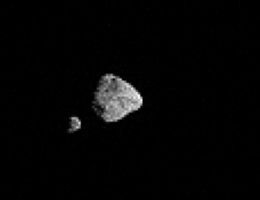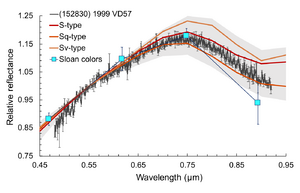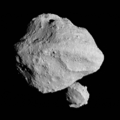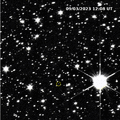152830 Dinkinesh facts for kids
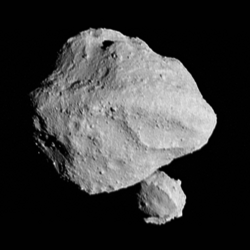
Dinkinesh and its satellite imaged by the Lucy spacecraft's L'LORRI camera
|
|
| Discovery | |
|---|---|
| Discovered by | LINEAR |
| Discovery site | Lincoln Lab ETS |
| Discovery date | 4 November 1999 |
| Designations | |
| MPC designation | (152830) Dinkinesh |
| 1999 VD57 · 2004 HJ78 · 2007 CB63 | |
| main-belt · (inner) | |
| Orbital characteristics | |
| Epoch 25 February 2023 (JD 2460000.5) | |
| Uncertainty parameter 0 | |
| Observation arc | 23.06 yr (8,422 days) |
| Earliest precovery date | 15 October 1999 |
| Aphelion | 2.437 AU |
| Perihelion | 1.946 AU |
| 2.191 AU | |
| Eccentricity | 0.1120 |
| 3.24 yr (1,185 d) | |
| 25.239° | |
|
Mean motion
|
0° 18m 13.874s / day |
| Inclination | 2.094° |
| 21.380° | |
| 66.711° | |
| Known satellites | 1 |
| Physical characteristics | |
|
Mean diameter
|
790 m (primary) |
| 52.67±0.04 h (satellite orbital period?) | |
| 0.27+0.25 −0.06 |
|
| Sq V–R = 0.455±0.025 |
|
| 17.62±0.04 (V-band) | |
152830 Dinkinesh is a small space rock, or asteroid, found in the main asteroid belt. It is about 790 meters (2,590 feet) wide. Scientists call it a "binary asteroid" because it has its own tiny moon.
Dinkinesh was first spotted on November 4, 1999. It was discovered by a project called LINEAR (Lincoln Near-Earth Asteroid Research). This project uses telescopes in Socorro, New Mexico, to find objects in space.
In 2023, Dinkinesh became the first asteroid visited by NASA's Lucy mission. The Lucy spacecraft flew very close to Dinkinesh. During this flyby, it discovered Dinkinesh's moon, which is about 220 meters (720 feet) across. Dinkinesh is the smallest main-belt asteroid ever explored by a spacecraft.
Contents
How Dinkinesh Was Discovered
Dinkinesh was discovered on November 4, 1999. It was found by the LINEAR sky survey in Socorro, New Mexico. At first, it was given a temporary name: 1999 VD57.
After its discovery, Dinkinesh was hard to keep track of. It was "lost" for several years. In 2004 and 2007, it was seen again. But astronomers didn't realize it was the same asteroid.
Finally, in 2007, an astronomer named Gareth Williams linked all the observations. He showed that these were all the same asteroid. This helped scientists figure out its path in space much better. Because of this, Dinkinesh got its permanent number, 152830, on April 2, 2007.
What's in a Name?
The name Dinkinesh comes from Ethiopia. It is the Ethiopian name for the famous Lucy fossil. The Lucy spacecraft mission is also named after this fossil.
In the Amharic language, "Dinkinesh" means "you are wonderful." The word "Din(i)k’i" means "wonderful," and "nesh" means "you are" (for a female).
The asteroid didn't have a name when the Lucy mission chose it as a target. So, the Lucy team suggested the name Dinkinesh. The International Astronomical Union approved the name on February 6, 2023.
Dinkinesh's Journey in Space
Dinkinesh travels around the Sun in the inner part of the main asteroid belt. This area is also known as the Kirkwood gap.
- Average Distance: Dinkinesh is usually about 2.19 AU (328 million kilometers or 204 million miles) from the Sun.
- Orbital Period: It takes Dinkinesh about 3.24 Earth years to orbit the Sun once.
- Shape of Orbit: Its path is not a perfect circle. It's an oval shape. At its closest, it's 1.95 AU from the Sun. At its farthest, it's 2.44 AU away.
- Tilt: Dinkinesh's orbit is tilted slightly, about 2.1 degrees, compared to the main plane of our Solar System.
Scientists think Dinkinesh might be part of the Flora family. This is a group of asteroids that have similar orbits.
Exploring Dinkinesh with Lucy
The Lucy spacecraft flew past Dinkinesh on November 1, 2023. It came within 425 kilometers (264 miles) of the asteroid.
NASA announced this flyby in January 2023. Dinkinesh was chosen as a target because it was a good test for Lucy's systems. The asteroid was originally thought to be too small to visit. But in August 2022, a scientist found it was a good match.
Lucys visit to Dinkinesh was its first and smallest asteroid flyby. It helped the mission test its special cameras and tracking tools. These tools will be used for Lucys main targets, which are the Jupiter trojans.
Lucy started taking pictures of Dinkinesh in September 2023. The asteroid was 23 million kilometers (14 million miles) away then. As Lucy got closer, it took more detailed images. It measured the asteroid's surface and looked at its materials. After the flyby, Lucy continued to watch Dinkinesh for several days.
Dinkinesh's Moon
During its flyby, the Lucy spacecraft made an exciting discovery. Dinkinesh has a natural satellite! This moon is about 220 meters (720 feet) wide. Dinkinesh and its moon form a binary system.
Dinkinesh is only the second binary asteroid in the main belt to be explored by a spacecraft. The first was 243 Ida, visited by the Galileo spacecraft in 1993.
Scientists think Dinkinesh's moon might have formed from Dinkinesh itself. If an asteroid spins very fast, it can throw off material. This material can then come together to form a moon. This process also slows down the asteroid's spin.
The moon of Dinkinesh does not have a name yet.
What Dinkinesh is Made Of
Surface Features
The surfaces of both Dinkinesh and its moon are covered with boulders and craters. Dinkinesh's shape is not perfectly smooth. This suggests it has been around for a long time.
Dinkinesh has a raised area, like a "ridge," around its middle. This might mean it has lost material in the past, possibly forming its moon. It also has another ridge branching off the main one.
Dinkinesh's shape is similar to other asteroids like 101955 Bennu and 162173 Ryugu. These asteroids are thought to be "rubble piles." This means they are collections of rocks and dust held together by gravity. Dinkinesh likely has this kind of structure too.
Its moon also has a ridge, but it's not around its middle. Scientists are still trying to figure out why.
Surface Materials
Scientists used telescopes to study the light reflecting off Dinkinesh. This helps them understand what it's made of. They found that Dinkinesh is an S-type asteroid. This means it's mostly made of rocky silicates and a small amount of metal.
Some observations show Dinkinesh is an "Sq-type" asteroid. This type has certain features in its light pattern. These features suggest it contains minerals like olivine and pyroxene.
Other observations show a slightly different light pattern. This could be because of small differences in how the light was measured. Or, it might mean that Dinkinesh's surface has different materials in different spots. If so, it could be due to impacts or its bumpy surface.
How Dinkinesh Spins
Dinkinesh spins slowly. It takes about 52.67 hours to complete one full rotation.
As Dinkinesh spins, its brightness changes when seen from Earth. This is because it's not a perfect sphere. Scientists use these changes in brightness to learn about its shape and how fast it rotates. Early observations helped confirm that Dinkinesh spins slowly.
Size and Brightness
Images from the Lucy spacecraft show Dinkinesh is about 790 meters (2,590 feet) wide. This matches earlier estimates made by other spacecraft.
Based on its size and how bright it appears, scientists can calculate its albedo. This is how much light its surface reflects. Dinkinesh's surface reflects about 27% of the sunlight that hits it. This is typical for S-type asteroids.
Images for kids



